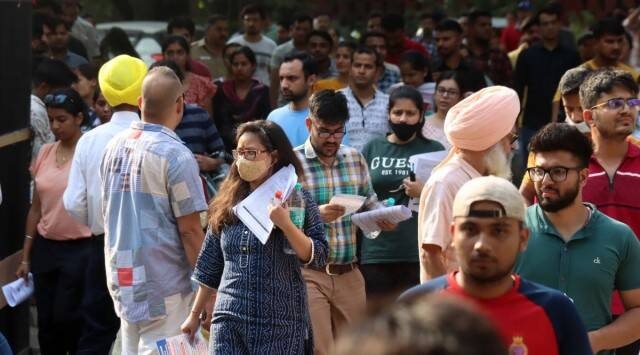
Jagdish Kumar, a UPSC aspirant from a quaint village in the Hissar district of Haryana studied through his school and college in Hindi medium. But as he browsed through the stocked-up bookselling shops of Delhi’s old Rajendra Nagar, he found limited study material in the Hindi language.
“For subjects like Science and Technology, internal security and environment, it gets impossible to find study material in Hindi. Let’s not even talk about optional subjects. I came to Delhi in the hope of finding a better coaching facility and study material but for aspirants preparing for exams other than in English medium, the UPSC road is 10 times tougher. Even the translated books have poor translations and aspirants like me end up reading English books and translating answers on our own,” Kumar highlighted.
Over the years, the number of students taking exams in Hindi and other regional languages has been declining sharply. (As per data available in the UPSC’s annual reports).
| Year | English | Hindi | Gujarati | Marathi | Tamil | Telugu |
| 2015 | 11790 | 2433 | 1120 | 168 | 23 | 33 |
| 2016 | 13457 | 1318 | 279 | 87 | 35 | 30 |
| 2017 | 11719 | 1065 | 210 | 87 | 28 | 16 |
| 2018 | 9109 | 888 | 199 | 75 | 22 | 15 |
| 2019 | 10708 | 570 | 67 | 49 | 21 | 8 |
| 2020 | 9711 | 584 | 44 | 43 | 25 | 4 |
| 2021 | 8362 | 470 | 20 | 30 | 5 |
5 |
Taking note of this, the Department-related Parliamentary Standing Committee on Personnel, Public Grievances, Law and Justice recently recommended forming an expert committee to assess if the present scheme of recruitment through civil services examination provides an equal opportunity to both English-medium-educated urban candidates and non-English medium-educated rural candidates.
While UPSC has changed the pattern of civil services examination from time to time on the basis of recommendations made by various expert committees, no study has been commissioned so far to assess how such changes impacted the aspirants, nature of recruitment and administration at large, it said.
The UPSC, in 2011, introduced the Civil Services Aptitude Test (CSAT) as a part of the Civil Services (Preliminary) Exam to test the analytical skills, reasoning ability and aptitude of the aspirants.
This move was widely criticised by aspirants especially the non-English medium candidates as the CSAT included questions on English comprehension.
The Nigvekar committee, which was appointed to examine the changes in the examination pattern, also observed that the CSAT exam pattern gave more advantages to English aspirants. Following this, through the Commission, the CSAT was made qualifying only in 2015.
However, the aspirants claim that the difficulty level of CSAT questions has increased over the years thus nullifying its qualifying exam stature.
This year’s Prelims exam saw a hue and cry from various aspirants claiming that the difficulty level of questions in CSAT was of the Common Admission Test (CAT) held for admissions to premier management institutes.
In a petition to the Central Administrative Tribunal, several aspirants demanded a lower CSAT qualifying cut-off due to the enhanced difficulty of the exam.
“It is submitted that the Paper II (CSAT) conducted by the UPSC is not only out of syllabus but is also discriminatory for the various categories of candidates i.e. candidates of humble background who cannot afford special coaching, candidates of rural background, candidates from arts/humanities,” the petition reads.
Swati Mishra, a UPSC aspirant from Lucknow said that the introduction of CSAT was unfair in itself for non-English medium students and with more difficult questions in the paper, it is tougher to get through the exam.
“Last year, I qualified GS I of the prelims exam but couldn’t qualify the CSAT. It was a hit to my confidence as even after studying so hard I couldn’t make it to Mains due to a qualifying paper. It’s already a battle for regional language exam takers to look for the study material and guidance for the exam. UPSC should be considerate of students from rural and Hindi-medium academic backgrounds,” Mishra said
Sarmad Mehraj, UPSC tutor at BYJU’S, also agreed that the CSAT exam pattern should be as per the syllabus defined by the UPSC.
“CSAT difficulty should be reduced to give a fair chance to candidates from rural areas, Hindi background aspirants and nonengineering background students. UPSC, as it stands today, appears to be biased against the Hindi-speaking audience,” Mehraj said.
Click Here for More Latest News
